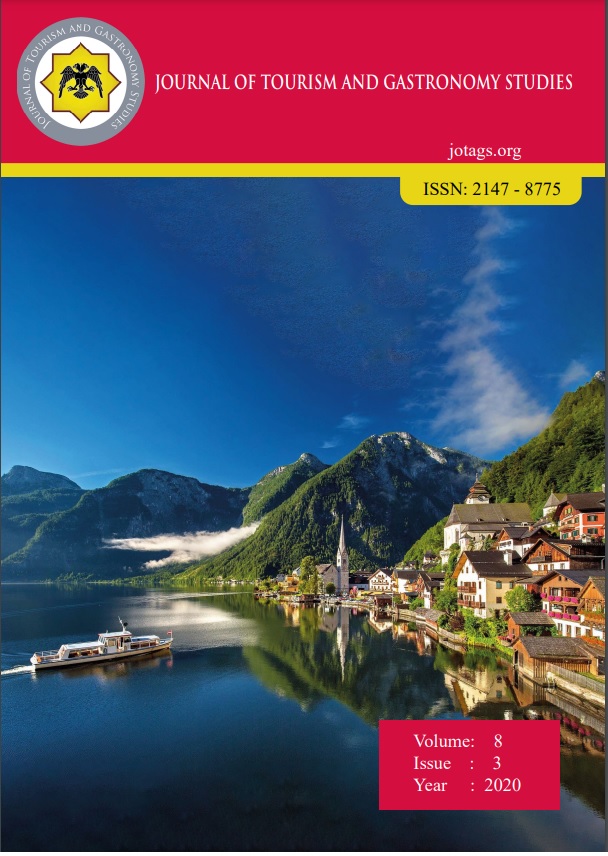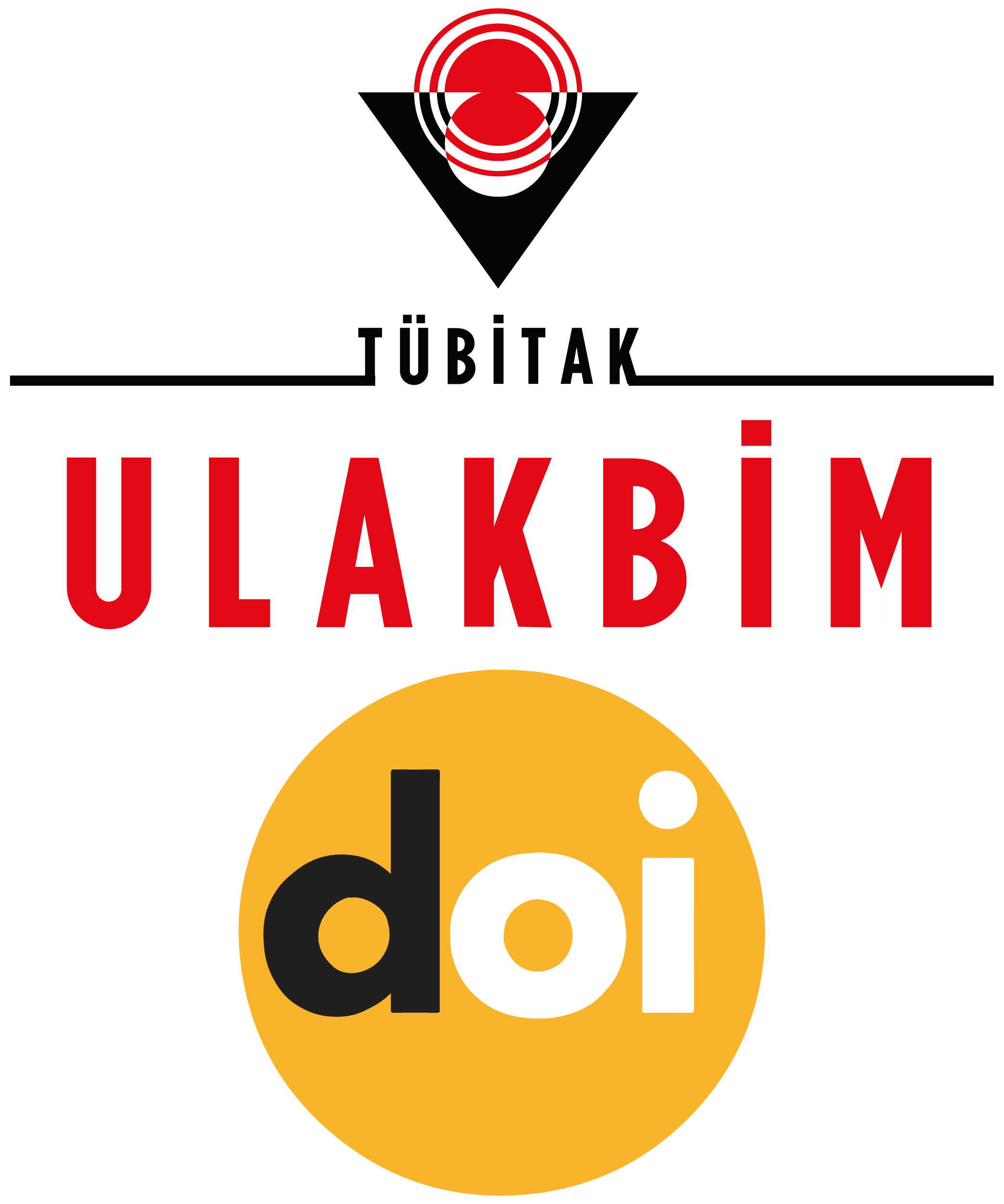Yerel Kalkınmanın Bir Aracı Olarak Kültür Turizmi ve Kültür Rotaları: Vezirköprü Yöresi Örneği (Cultural Tourism and Cultural Routes as an Instrument of Local Development: The Case of Vezirköprü Area)
DOI:
https://doi.org/10.21325/jotags.2020.638Keywords:
Sustainable tourism, Culture tourism, Cultural routes, Samsun, VezirköprüAbstract
Turkey has many cultural routes that offer rich and impressive examples of the world's common heritage. These routes offer important opportunities for sustainable local development with their economic, social, environmental and cultural effects. This study focuses on the local culture routes that can be developed in the case of Vezirköprü (Samsun) region as a cultural tourism product. Initially, the main characteristics of the culture routes were explained and the main factors affecting the development of these routes were introduced. The study aims to present the natural, historical and cultural values of Vezirköprü region as a touristic product with the help of cultural routes in the context of the relationship between culture and tourism and to make local cultural heritage more visible. The method of Cultural Route Planning Model was used in the study. This model consists of (1) infrastructure, (2) overview, (3) planning and (4) management stages. As a result of the study, five cultural routes at local level in Vezirköprü were designed using the Cultural Route Planning Model. Besides, it has been concluded that the Kunduz Mountain Route can be integrated into the national Gastronomy Route and the Nerik-Şahinkaya Canyon Route into the national the Hittite Route.
References
Başbakanlık Kanunlar ve Kararlar Genel Müdürlüğü (2012). Kültür rotalarına ilişkin genişletilmiş kısmi anlaşması tesis eden CM/RES (2010) 53 sayılı karar. Retrieved from https://www2.tbmm.gov.tr/d24/1/1-0686.pdf
Bekker-Nielsen, T., Czichon, R., Høgel, C., Kıvrak, B., Majbom, J. M., Sauer, V., Sørensen, S.L., Sauer, V., & Winther-Jacobsen, K. (2015). Neoklaudiopolis Antik Kenti (Vezirköprü-Samsun): Tarihsel ve Arkeolojik Rehber. İstanbul: Arkeoloji ve Sanat Yayınları.
Campolo, D., Bombino, G., & Meduri, T. (2016). Cultural landscape and cultural routes: infrastructure role and indigenous knowledge for a sustainable development of inland areas. Procedia-Social and Behavioral Sciences, 223, 576-582.
Cojocariu, S. (2015). The development of cultural routes: a valuable asset for Romania. Procedia Economics and Finance, 32, 959-967.
Council of Europe (2015). Europe Cultural Routes. Retrieved from http://www.coe.int/t/dg4/cultureheritage/culture/routes/jewish_en.asp
Council of Europe (2019a). Cultural Routes: newsroom: The Council of Europe certifies 5 new Cultural Routes. Retrieved from https://www.coe.int/en/web/cultural-routes/-/the-council-of-europe-certifies-5-new-cultural-routes
Council of Europe (2019b). 50 years of the European Cultural Convention. Retrieved from https://www.coe.int/t/dg4/CulturalConvention/Source/Bilan50_EN.pdf
Council of Europe (2020a). Cultural tourism. Retrieved from https://ec.europa.eu/growth/sectors/tourism/offer/cultural_en
Council of Europe (2020b). Cultural Routes: Cultural Routes of the Council of Europe programme. Retrieved from https://www.coe.int/en/web/cultural-routes/about
Council of Europe (2020c). The Enlarged Partial Agreement on Cultural Routes of the Council of Europe. Retrieved from https://www.coe.int/en/web/cultural-routes/epa-member-states
Council of Europe (2020d). Cultural Routes of the Council of Europe: Cultural Routes. Retrieved from https://www.euro-access.eu/programm/cultural_routes_of_the_ council_of_europe
ÇEKÜL (2015). Kültür rotaları planlama rehberi. Tarihi Kentler Birliği Yayınları, Kılavuz Kitapçıklar Dizisi 3. İstanbul: Stil Matbaa.
Demirel, E. (2010). Hitit yürüyüş parkurları. İstanbul: Pegasus Yayınevi.
Demirel, E. (2012). Kızılırmak havzası gastronomi ve yürüyüş yolu. Çorum: Çorum İl Özel İdaresi Yayınları.
Devereux, C., & Carnegıe, E. (2006). Pilgrimage: journeying beyond self. Tourism Recreation Research, 31, 47-49.
Di Pietro, L., Mungion, R. G., & Renzi, M.F. (2013). Cultural technology district: a model for local and regional development. Current Issues in Tourism, 16(1), 1-17. Retrieved from https://www.tandfonline.com/doi/pdf/10.1080/13683500.2013.789006?needAccess=true
Doğaner, S. (2013). Türkiye kültür turizmi. Sosyologca Kitaplar Dizisi-13. İstanbul: Doğu Kitapevi.
Emekli, G. (2006). Coğrafya, kültür ve turizm: Kültürel turizm. Ege Coğrafya Dergisi,15, 51-59.
Fang, K., & Zimmerman, S. (2015). Public transport service optimization and system integration. China transport topics; no. 14. Washington, DC: World Bank Group
Global Sustainable Tourism Council (2020). The global baseline standards sustainable travel and tourism. Retrieved from https://www.gstcouncil.org/gstc-criteria/
Görmüş, S. (2017). Kültürel peyzaj değerlerini korumak için yeni bir yaklaşım: kültürel rotalar. Plant Peyzaj ve Süs Bitkiciliği Dergisi, 25, 123-130.
Günal, V., Alaeddinoğlu, F., & Şahinalp, M.S. (2009). Türkiye’ye yönelik kültürel turizm turları ve başlıca güzergâhlar. Gaziantep Üniversitesi Sosyal Bilimler Dergisi, 8(1), 275–298.
Güvenç, B. (1994). İnsan ve kültür (6. baskı). İstanbul: Remzi Kitabevi.
ICOMOS (2015). Kültür rotaları. Retrieved from http://www.icomos-ciic.org/INDEX_ingl.htm
İğci, N., & Kıvrak, B. (Ed.). (2008). Geçmişten günümüze Vezirköprü. Vezirköprü Kaymakamlığı yayınları.
Khovanova-Rubicondo, K. (2011). Impact of European Cultural Routes on SMEs’ innovation and competitiveness. Strasbourg: Council of Europe Publishing (provisional). Retrieved from http://ec. europa. eu/enterprise/sectors/tourism/cultural-routes/pavia-2012/index_en. htm.
Kong-jian, L. W. Y. (2005). New direction in the conservation of world heritage: Cultural routes (cultural itineraries)[J]. Urban Problems, 4.
Kültür Rotaları Derneği (2019a). Hitit yolu. Retrieved from http://cultureroutesinturkey.com/tr/hitit-yolu/
Kültür Rotaları Derneği (2019b). Gastronomi yolu. Retrieved from http://cultureroutesinturkey.com/tr/gastronomi-yolu/
Kültür Rotaları Derneği (2020). Ulusal kültür rotaları. Retrieved from http://cultureroutesinturkey.com/tr/tum-rotalar/
Murray Mas, I. (2012). Geografies del capitalisme balear: poder, metabolisme socioeconòmic i petjada ecològica d’una superpotència turística. (Doctoral dissertation, Universitat Illes Balears). Retrieved from www.tdx.cat/handle/10803/104203
Orta Karadeniz Kalkınma Ajansı (2014). TR83 bölgesi ilçeleri sosyo-ekonomik gelişmişlik analizi (SEGE). Retrieved from http://www.oka.org.tr/Documents/Geli%C5%9Fmi% C5%9Flik2.pdf
Özgüç, N. (2007). Turizm coğrafyası. İstanbul: Çantay Kitabevi.
Pattanaro, G., & Pistocchi, F. (2016). Linking destinations through sustainable cultural routes. Symphonya. Emerging Issues in Management,1, 83-96.
Richards, G. (2001). The development of cultural tourism in Europe. New York: Cabi Publishing.
Sarı, C., & Ertürk, M. (2017). Batı Toroslarda Yörük göç yollarının turizm amaçlı kullanımına yönelik planlama önerileri. Turkish Studies, 12(24), 159–178.
Tümertekin, E., & Özgüç, N. (2003). Beşeri Coğrafya: İnsan, Kültür, Mekân. İstanbul: Çantay Kitabevi.
Uğur, E. (2008). Kültür turizmi bağlamında kültür rotaları: Türkiye’deki kültür rotası örnekleri üzerine bir inceleme. (Uzmanlık tezi, Kültür ve Turizm Bakanlığı, Ankara). Retrieved from http://aregem.kulturturizm.gov.tr/Eklenti/30934,enis-ugur---uzmanlik-tezipdf.pdf?0
Üsküdar, Ş., Çakır, M., & Temizkan, S.P. (2014). Yerli turistlerin Eskişehir’in kültür turizmine ilişkin algıları. Journal of Tourism and Gastronomy Studies, 2(2), 67-76.
UNESCO (1994). Routes as part of our cultural herıtage report on the meetıng of experts. Retrieved from https://whc.unesco.org/archive/routes94.htm
UNWTO (2015). Affiliate members global reports: Cultural routes and ıtineraries. Madrid: UNWTO. Retrieved from https://catedratim.files.wordpress.com/2017/01/omt-2015-global_report_cultural_routes_itineraries.pdf
UNWTO (2020). International tourism results 2019 and outlook 2020. Retrieved from https://webunwto.s3.eu-west-1.amazonaws.com/s3fs-public/2020-01/UNWTO_Barom20_01_January_excerpt_0.pdf
Yılmaz, A. (2016). Coğrafya ve turizm. İçinde S. Günay Aktaş (Edt.), Turizm Coğrafyası, (ss.39-60). Eskişehir: Anadolu Üniversitesi Yayınları.
Downloads
Published
How to Cite
Issue
Section
License
Copyright (c) 2023 Journal of Tourism & Gastronomy Studies

This work is licensed under a Creative Commons Attribution-NonCommercial 4.0 International License.








